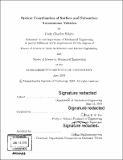Optical coordination of surface and subsurface autonomous vehicles
Author(s)
White, Cody Charles.
Download1119389099-MIT.pdf (12.99Mb)
Other Contributors
Massachusetts Institute of Technology. Department of Mechanical Engineering.
Advisor
Dick K. P. Yue.
Terms of use
Metadata
Show full item recordAbstract
Much work has been done in the development of autonomous systems for use at sea. They provide a useful way of carrying out a variety of tasks, from exploration to data collection. The vast expanse of the ocean has naturally led to interest in networks of independent, autonomous vehicles that can act in a coordinated manner, or swarm. Current swarm technology has focused on the surface of the water. However, it is desirable to be able to perform measurements at varying depths. In order to expand swarm capabilities, this work investigates using low-cost cameras and light communication to provide navigation for a subsurface sensing vehicle, by allowing it to follow a surface vehicle. This would allow for data collection at various depths, expanding the capability of the existing swarm, while maintaining the coordination of the swarm on the water's surface. This leverages the benefits of wireless communication and GPS. This work focused on developing an understanding of the potential capabilities that could be expected as a result of utilizing low-cost cameras for guidance. Testing was performed to examine tracking algorithm performance in both relatively clear testing tank water as well as turbid pond water. Using a low-cost, 5.0 Megapixel USB camera, testing showed reliable tracking performance out to a maximum range of 40 feet in clear water. Additionally, this work focused on creating an underwater platform to facilitate testing of various tracking algorithms. The platform utilizes a vertically facing USB camera, incorporated into the guidance and propulsion system of an autonomous surface vehicle. This platform allows further testing of tracking schemes as well as environmental effects, such as wave and target motion, water clarity, and ambient light.
Description
Thesis: S.M., Massachusetts Institute of Technology, Department of Mechanical Engineering, 2019 Cataloged from PDF version of thesis. Includes bibliographical references (pages 97-98).
Date issued
2019Department
Massachusetts Institute of Technology. Department of Mechanical EngineeringPublisher
Massachusetts Institute of Technology
Keywords
Mechanical Engineering.